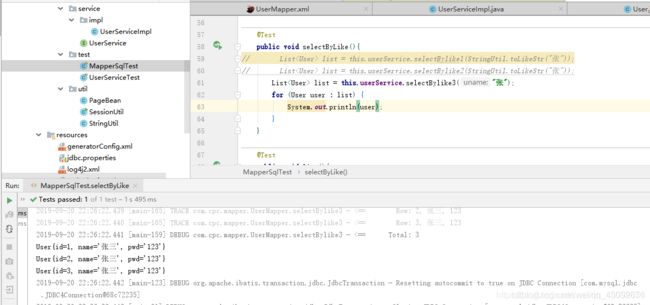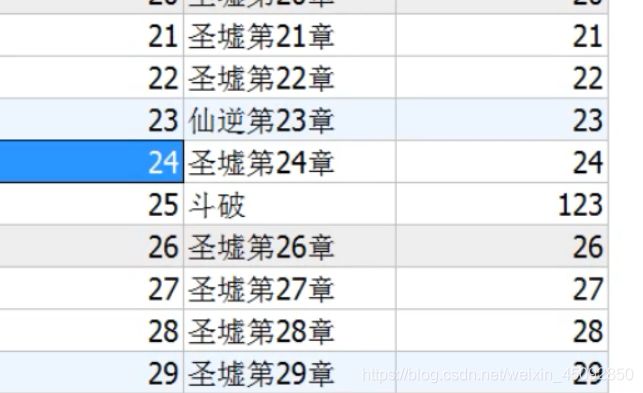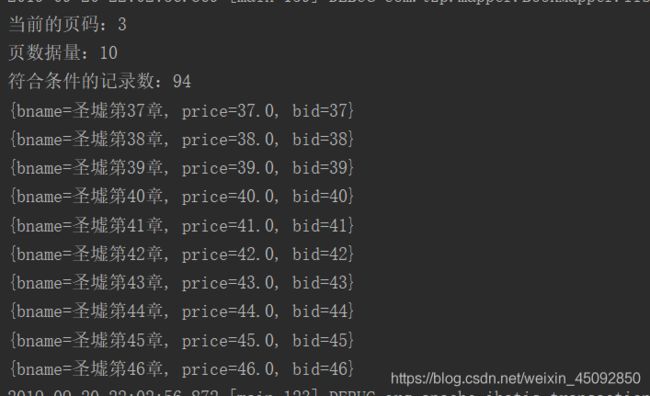mybaits的动态sql及模糊查询与分页
文章目录
- mybaits动态sql
- 模糊查询
- 查询返回结果集的处理
- 分页查询
- 特殊字符处理
mybaits动态sql
if
如果name不为空,就进行拼接if体
#{bname,jdbcType=VARCHAR},
trim
trim则是去空格。
<trim prefix="values (" suffix=")" suffixOverrides="," >
<if test="bid != null" >
#{bid,jdbcType=INTEGER},
if>
<if test="bname != null" >
#{bname,jdbcType=VARCHAR},
if>
<if test="price != null" >
#{price,jdbcType=REAL},
if>
trim>
foreach
collection 对应的是你要遍历的集合,这里我是从接口那边定义传过来的。
open 是当循环开始时在前面加的字符。
close 是当循环结束时在后面加的字符。
separator 是使用什么隔开。
item 则是代表着集合中的每个元素。
<foreach collection="bookIds" open="(" close=")" separator="," item="bid">
#{bid}
foreach>
模糊查询
接口
// 模糊查询三种方法
List<Book> selectBylike1(@Param("bname") String bname);
List<Book> selectBylike2(@Param("bname") String bname);
List<Book> selectBylike3(@Param("bname") String bname);
xml配置
<select id="selectBylike1" resultType="com.tzp.model.Book" parameterType="java.lang.String">
select * from t_mvc_book where bname like #{bname}
select>
<select id="selectBylike2" resultType="com.tzp.model.Book">
select * from t_mvc_book where bname like '${bname}'
select>
<select id="selectBylike3" resultType="com.tzp.model.Book">
select * from t_mvc_book where bname like concat(concat('%',#{bname}),'%')
select>
测试
public void selectBylike() {
List<Book> bb = this.bookService.selectBylike1(StringUtils.toLikeStr("圣墟"));
// List bb = this.bookService.selectBylike2(StringUtils.toLikeStr("圣墟"));
// List bb = this.bookService.selectBylike3(StringUtils.toLikeStr("圣墟"));
for (Book book : bb) {
System.out.println(book);
}
}
mybaits里面的 #传参与 $ 传参有什么区别?
也是就是上面的第一种的方法和第二种方法的区别
-
#将传入的数据都当成一个字符串,会对自动传入的数据加一个双引号。
如:order by #user_id#,如果传入的值是111,那么解析成sql时的值为order by ‘111’,
如果传入的值是id,则解析成的sql为order by “id”. -
$将传入的数据直接显示生成在sql中。
如:order by u s e r i d user_id userid,如果传入的值是111,那么解析成sql时的值为order by user_id,
如果传入的值是id,则解析成的sql为order by id. -
#方式能够很大程度防止sql注入。
-
$方式无法防止Sql注入。
-
$方式一般用于传入数据库对象,例如传入表名.
查询返回结果集的处理
resultMap:适合使用返回值是自定义实体类的情况
resultType:适合使用返回值的数据类型是非自定义的,即jdk的提供的类型
在第一种方法中就使用了这个BaseResultMap
<resultMap id="BaseResultMap" type="com.cpc.model.User" >
<constructor >
<idArg column="id" jdbcType="INTEGER" javaType="java.lang.Integer" />
<arg column="name" jdbcType="VARCHAR" javaType="java.lang.String" />
<arg column="pwd" jdbcType="VARCHAR" javaType="java.lang.String" />
constructor>
resultMap>
BookVo类用来存放包括数据库表映射字段以及多余查询条件所需属性
public class BookVo extends Book{
private List bookIds;
private float min;
private float max;
public float getMin() {
return min;
}
public void setMin(float min) {
this.min = min;
}
public float getMax() {
return max;
}
public void setMax(float max) {
this.max = max;
}
public List getBookIds() {
return bookIds;
}
public void setBookIds(List bookIds) {
this.bookIds = bookIds;
}
}
接口
后两种方法使用于适用于多表查询返回单个结果集
// 3.1 使用resultMap返回自定义类型集合
List<Book> list1();
// 3.2 使用resultType返回List,适用于多表查询返回单个结果集
Map list5(Map map);
第一种方法要写一个拼接sql方法 使用resultMap返回自定义类型集合
public class StringUtils {
public static String toLikeStr(String str){
return "%"+str+"%";
}
}
xml配置
<select id="list1" resultMap="BaseResultMap">
select * from t_mvc_book
select>
<select id="list2" resultType="com.tzp.model.Book">
select * from t_mvc_book
select>
<select id="list3" resultType="com.tzp.model.Book" parameterType="com.tzp.model.BookVo">
select * from t_mvc_book where bid in
<foreach collection="bookIds" open="(" close=")" separator="," item="bid">
#{bid}
foreach>
select>
<select id="list4" resultType="java.util.Map" parameterType="java.util.Map">
select * from t_mvc_book
<where>
<if test="null != bname and bname != ''">
and bname like #{bname}
if>
where>
select>
<select id="list5" resultType="java.util.Map" parameterType="java.util.Map">
select * from t_mvc_book
<where>
<if test="null != bid and bid != ''">
and bid like #{bid}
if>
where>
select>
测试
@Test
public void list() {
// 返回redultMap但是使用list books = this.bookService.list1();
// 返回redulttype但是使用list books = this.bookService.list2();
//
// for (Book book : books) {
//
// System.out.println(book);
// }
// 返回的是resultype使用接收
// BookVo bookVo = new BookVo();
// List list = new ArrayList();
// list.add(27);
// bookVo.setBookIds(list);
// Book book = this.bookService.list3(bookVo);
// System.out.println(book);
// 返回的是resultype,然后使用list
Map map = new HashMap();
// map.put("bname",StringUtils.toLikeStr("圣墟"));
// List
// for (Map m : list) {
// System.out.println(m);
// }
// 返回的是resuType,然后使用Map进行接收
map.put("bid",27);
Map map1 = this.bookService.list5(map);
System.out.println(map1);
}
分页查询
为什么要重写mybatis的分页?
Mybatis的分页功能很弱,它是基于内存的分页(查出所有记录再按偏移量offset和边界limit取结果),在大数据量的情况下这样的分页基本上是没有用的
使用分页插件步奏
1、导入pom依赖
<dependency>
<groupId>com.github.pagehelpergroupId>
<artifactId>pagehelperartifactId>
<version>5.1.2version>
dependency>
2、Mybatis.cfg.xml配置拦截器
要配在配置mybatis运行环境上面
<plugins>
<plugin interceptor="com.github.pagehelper.PageInterceptor">
plugin>
plugins>
3、使用PageHelper进行分页
工具类PageBean
package com.tzp.util;
import javax.servlet.http.HttpServletRequest;
import java.io.Serializable;
import java.util.Map;
public class PageBean implements Serializable {
private static final long serialVersionUID = 2422581023658455731L;
//页码
private int page=1;
//每页显示记录数
private int rows=10;
//总记录数
private int total=0;
//是否分页
private boolean isPagination=true;
//上一次的请求路径
private String url;
//获取所有的请求参数
private Map<String,String[]> map;
public PageBean() {
super();
}
//设置请求参数
public void setRequest(HttpServletRequest req) {
String page=req.getParameter("page");
String rows=req.getParameter("rows");
String pagination=req.getParameter("pagination");
this.setPage(page);
this.setRows(rows);
this.setPagination(pagination);
this.url=req.getContextPath()+req.getServletPath();
this.map=req.getParameterMap();
}
public String getUrl() {
return url;
}
public void setUrl(String url) {
this.url = url;
}
public Map<String, String[]> getMap() {
return map;
}
public void setMap(Map<String, String[]> map) {
this.map = map;
}
public int getPage() {
return page;
}
public void setPage(int page) {
this.page = page;
}
public void setPage(String page) {
if(null!=page&&!"".equals(page.trim()))
this.page = Integer.parseInt(page);
}
public int getRows() {
return rows;
}
public void setRows(int rows) {
this.rows = rows;
}
public void setRows(String rows) {
if(null!=rows&&!"".equals(rows.trim()))
this.rows = Integer.parseInt(rows);
}
public int getTotal() {
return total;
}
public void setTotal(int total) {
this.total = total;
}
public void setTotal(String total) {
this.total = Integer.parseInt(total);
}
public boolean isPagination() {
return isPagination;
}
public void setPagination(boolean isPagination) {
this.isPagination = isPagination;
}
public void setPagination(String isPagination) {
if(null!=isPagination&&!"".equals(isPagination.trim()))
this.isPagination = Boolean.parseBoolean(isPagination);
}
/**
* 获取分页起始标记位置
* @return
*/
public int getStartIndex() {
//(当前页码-1)*显示记录数
return (this.getPage()-1)*this.rows;
}
/**
* 末页
* @return
*/
public int getMaxPage() {
int totalpage=this.total/this.rows;
if(this.total%this.rows!=0)
totalpage++;
return totalpage;
}
/**
* 下一页
* @return
*/
public int getNextPage() {
int nextPage=this.page+1;
if(this.page>=this.getMaxPage())
nextPage=this.getMaxPage();
return nextPage;
}
/**
* 上一页
* @return
*/
public int getPreivousPage() {
int previousPage=this.page-1;
if(previousPage<1)
previousPage=1;
return previousPage;
}
@Override
public String toString() {
return "PageBean [page=" + page + ", rows=" + rows + ", total=" + total + ", isPagination=" + isPagination
+ "]";
}
}
BookService 的接口方法
// 分页查询
List<Map> listPager(Map map, PageBean pageBean);
在实现类BookServiceImpl实现这个方法
@Override
public List<Map> listPager(Map map, PageBean pageBean) {
if(pageBean !=null && pageBean.isPagination()){
PageHelper.startPage(pageBean.getPage(),pageBean.getRows());
}
List<Map> list = this.bookMapper.list4(map);
if(pageBean !=null && pageBean.isPagination()){
PageInfo pageInfo = new PageInfo(list);
System.out.println("当前的页码:"+pageInfo.getPageNum());
System.out.println("页数据量:"+pageInfo.getPageSize());
System.out.println("符合条件的记录数:"+pageInfo.getTotal());
pageBean.setTotal(pageInfo.getTotal()+"");
}
return list;
}
4、处理分页结果
测试
@Test
public void listPager() {
Map map = new HashMap();
map.put("bname",StringUtils.toLikeStr("圣墟"));
PageBean pageBean = new PageBean();
pageBean.setPage(3);
// 控制是否分页
pageBean.setPagination(false);
List<Map> maps = this.bookService.listPager(map, pageBean);
for (Map m : maps) {
System.out.println(m);
}
}
特殊字符处理
在mybaits中,不是使用大于或者小于符号,它是会报错的,他有专门的方法来表示的。
第一种方式:
大于:>
小于:<
空格:&
接口
Listxml配置
<select id="list6" resultType="java.util.Map" parameterType="com.tzp.model.BookVo">
select * from t_mvc_book
<where>
<if test="null != min and min != ''">
and price > #{min}
if>
<if test="null != max and max != ''">
and price < #{max}
if>
where>
select>
测试
@Test
public void sqlSpecial() {
BookVo bookVo = new BookVo();
bookVo.setMax(30);
bookVo.setMin(20);
List<Map> maps = this.bookService.list6(bookVo);
for (Map m : maps) {
System.out.println(m);
}
}
第二种方式:
在sql语句前加上
后加上 ]]>
接口
List<Map> list7(BookVo bookVo);
xml配置
<select id="list7" resultType="java.util.Map" parameterType="com.tzp.model.BookVo">
select * from t_mvc_book
<where>
<if test="null != min and min != ''">
if>
<if test="null != max and max != ''">
if>
where>
select>


